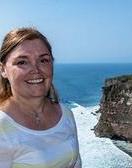My current Facebook profile photo has changed; I now have a face painted with native designs. Dan took it while we were visiting an Amazon tribe called the Kichwa, and I wrote about my Kichwa face painting experience last week.
If you have ever visited Ecuador, Peru or Colombia you may have heard of the Quechua; same people, different spelling. I spell it the way the tribe had it spelled on their sign. I figured they would know.
Anyway, if you hear an unusual, non-Spanish language being spoken in Cuenca, it’s Quechua (and everyone spells the language like that).

The Kichwa community gets a lot of its income from community-based tourism, sharing their skills and traditions with visitors who seek to experience a way of life different from what they know at home. They continue to speak their own language, prepare and share their traditional foods and chicha drink, use the same medicinal plants their grandparents used, and their children still respect their elders. Their ancient traditions are alive and well, and our recent Amazon trip gave us the opportunity to appreciate them.
We visited the Kichwa while we were staying at Cotococha Lodge on the Napo River. River travel is the preferred way to get around in the Amazon, so we got there by boat. As we traveled we saw people panning for gold along the shore. The gold washes down from high in the Andes, where the Incas once lived, and everyone in the area knows it.
It’s common for locals to spend days or weeks panning for gold, then as soon as they get enough, they’ll sell it and take a few months off living off the proceeds. Once they run out of money, they’ll return to the rivers’ shores with their pans, and do it all over again.
I don’t know if that’s how the Kichwa do things, though.
How the Kichwa pan for gold
Our Kichwa community tour began even before our boat landed, as we saw a Kichwa panning in the river while awaiting our arrival.
As we disembarked our guide introduced us to Mariana, standing on the shoreline’s rocks with her pan. They may call it a pan, but it really looks like a very shallow wooden bowl. I’m guessing they need huge trees to make them, too, because the ones they use every day are larger than the one she was using during her demonstration.
Whenever there’s a big storm up in the Andes, the water runs down into the river, bringing sediment (and gold) along with it. As the river rises, then drops, it leaves behind 10-20 centimeters of new sediment along the banks. This is what they put into their pans.

Down at the river they put their pans in the water and gently swirl the dirt inside to get rid of the silt and wash off the rocks. As the rocks are cleaned they sweep them out of the pan.

They continue to swirl and sweep until all the large pieces are gone and only a little bit of fine sediment remains in the bottom of the pan.

At this point they wash what remains again and again, looking for anything that might look like gold.

The gold comes down from the mountain as minuscule flecks. It can be very easy to miss if you don’t know what you’re looking for.

After her demonstration we headed into the community center so we could try our hand at a blow dart gun, drinking chicha, and learning more about their culture.
Please let us know what you think in the comments below.
- Share on Facebook.
- Share on Google+
- Share on LinkedIn
- Share on Twitter.


posted on 22 October at 12:22
so nice i need this all dear i wanna find a gold in pakistan